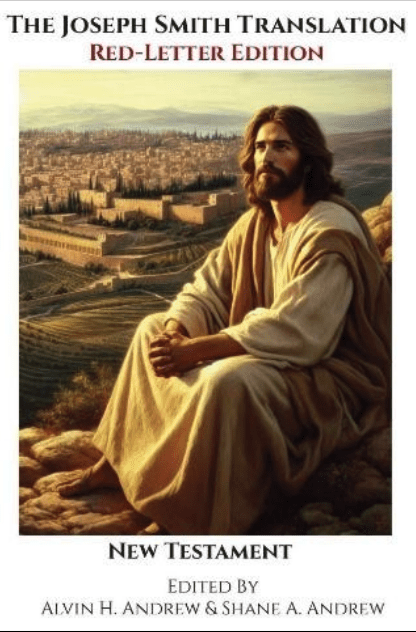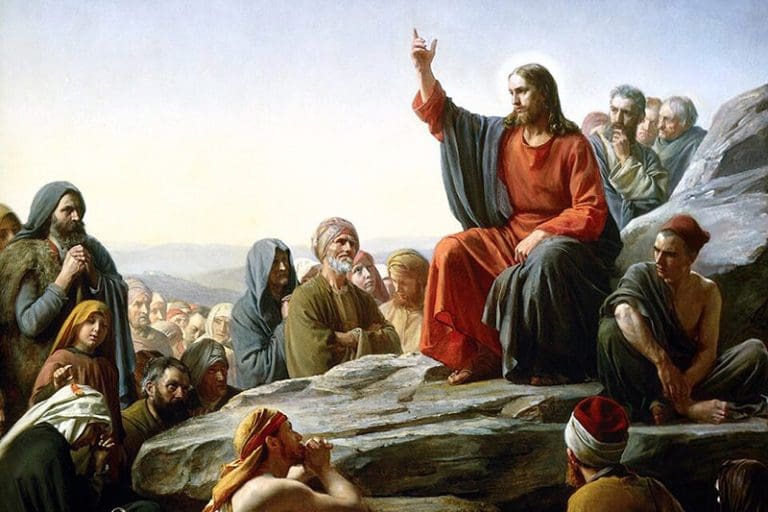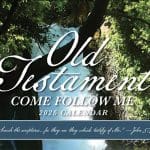 Among the many changes the Joseph Smith Translation (JST) made to the King James Version (KJV) of the Holy Bible are those that are doctrinally significant to Latter-Day Saints, some that clarify events, and others that add significantly to our understanding and context of stated doctrines or events.
Among the many changes the Joseph Smith Translation (JST) made to the King James Version (KJV) of the Holy Bible are those that are doctrinally significant to Latter-Day Saints, some that clarify events, and others that add significantly to our understanding and context of stated doctrines or events.
As in previous articles, chapter numbering and textual highlighting are taken from The Joseph Smith Translation, Red-Letter Edition, New Testament, wherein red print highlights the JST alterations and blue print with a strikethrough shows how the KJV read previously.1 The Sermon on the Mount in JST Matthew, chapters 5, 6, and 7, contains some of the most frequently quoted and powerful New Testament verses. Luke 6:17-49 also records some of that sermon, but without as much clarity, especially with regard to the audience.
A careful reading of the sermon in the JST Matthew places this event into a more specialized setting. We learn from the JST that the Sermon on the Mount was a missionary training meeting. It was specifically aimed at the disciples of Jesus Christ who were preparing to embark on missions to teach, baptize, and warn the people of Israel. Notice how the following verses reveal the identity of the audience of the sermon. (The italics are mine.)
 While the KJV verses allude to the disciples being the audience for the sermon in Matthew 5:1 and Luke 6:20, it is more clearly defined in JST Matthew 6:1, 7:1, and 8:1. Luke 6:20-49 in both the KJV and the JST continue the sermon, but neither distinguishes the audience nor the concepts taught as clearly as the verses in JST Matthew. The KJV almost makes the Sermon on the Mount appear as though it happened randomly and that it was addressed to the great multitudes following Christ. The JST alters that view and more specifically identifies both the purpose of the sermon as well as the intended audience. A JST verse inserted into the sermon specifically identifies the mission of the disciples and their required faith and commitment.
While the KJV verses allude to the disciples being the audience for the sermon in Matthew 5:1 and Luke 6:20, it is more clearly defined in JST Matthew 6:1, 7:1, and 8:1. Luke 6:20-49 in both the KJV and the JST continue the sermon, but neither distinguishes the audience nor the concepts taught as clearly as the verses in JST Matthew. The KJV almost makes the Sermon on the Mount appear as though it happened randomly and that it was addressed to the great multitudes following Christ. The JST alters that view and more specifically identifies both the purpose of the sermon as well as the intended audience. A JST verse inserted into the sermon specifically identifies the mission of the disciples and their required faith and commitment.
 In conjunction with their missionary training from the Savior, the disciples were taught numerous doctrines and principles pertinent to their missionary efforts. One article cannot efficiently deal with all the alterations made by the JST to the Sermon on the Mount, but we will explore a couple.
In conjunction with their missionary training from the Savior, the disciples were taught numerous doctrines and principles pertinent to their missionary efforts. One article cannot efficiently deal with all the alterations made by the JST to the Sermon on the Mount, but we will explore a couple.
Judgement
Some of the verses frequently quoted from the Sermon on the Mount concern judging others. The Savior addressed this in his instructions to his disciples. Notice how the JST brings it more clearly into a proper context.
 The Lord repeated this counsel to Jewish rulers in John 7:24.
The Lord repeated this counsel to Jewish rulers in John 7:24.
 Judging is not simply disregarded as the KJV seems to imply, but we are to “…judge righteous judgment” in circumstances that require making decisions regarding each other’s behavior. While not found in the Sermon on the Mount, another remarkable set of verses in JST Mark 9:42-50 clarifies some of the judgments we must carefully make regarding the behavior of others.
Judging is not simply disregarded as the KJV seems to imply, but we are to “…judge righteous judgment” in circumstances that require making decisions regarding each other’s behavior. While not found in the Sermon on the Mount, another remarkable set of verses in JST Mark 9:42-50 clarifies some of the judgments we must carefully make regarding the behavior of others.
 It appears from this JST rendering of verses that the hand is one that was a trusted part of the community, who, because of errant behavior, is not one whom we should continue to trust to teach us the Lord’s gospel. The foot appears to be those of some influence in the Church that transgress, falling away from the Lord’s designated path, and in whom we may have leaned on for our testimony or understanding of the Lord’s will. The Lord then counsels us to stand up on our own and seek our Father, having our own testimony, founded in our own faith in Him, independent of others around us. The eye is one called to “watch over” us and who has been charged to receive inspiration for our guidance, but who has fallen due to significant transgression. The Lord finally summarizes the concept of being independent in testimony and faith, allowing us to become the seasoning or salt wherewith we may succor one another. This is a marvelous section of the JST that teaches us to judge carefully the circumstances of one’s behavior and then helps us to understand the importance of developing our personal testimony and faith in the Lord in order to succor others.
It appears from this JST rendering of verses that the hand is one that was a trusted part of the community, who, because of errant behavior, is not one whom we should continue to trust to teach us the Lord’s gospel. The foot appears to be those of some influence in the Church that transgress, falling away from the Lord’s designated path, and in whom we may have leaned on for our testimony or understanding of the Lord’s will. The Lord then counsels us to stand up on our own and seek our Father, having our own testimony, founded in our own faith in Him, independent of others around us. The eye is one called to “watch over” us and who has been charged to receive inspiration for our guidance, but who has fallen due to significant transgression. The Lord finally summarizes the concept of being independent in testimony and faith, allowing us to become the seasoning or salt wherewith we may succor one another. This is a marvelous section of the JST that teaches us to judge carefully the circumstances of one’s behavior and then helps us to understand the importance of developing our personal testimony and faith in the Lord in order to succor others.
Even knowing some of the circumstances when we must judge, we must carefully follow the Lord’s counsel as stated by then Elder Dallin H. Oaks: “In the intermediate judgments we must make, we should take care to judge righteously. We should seek the guidance of the Spirit in our decisions. We should limit our judgments to our own stewardships. Whenever possible, we should refrain from judging people until we have adequate knowledge of the facts. So far as possible, we should judge circumstances rather than people. In all our judgments, we should apply righteous standards. And, in all of this, we must remember the command to forgive.”2
Commitment
The Savior also instructed the disciples to teach the people about commitment and loyalty to God. This counsel is highly germane to our day with all the distractions available to us from the internet with our smart phones, digital games, videos and images, sports, and a host of other items and activities. When one overindulges in any of these activities it is easy for us to lose our commitment to each other, to our family, to our community, to the Church, and to our Lord and Savior. While no new LDS doctrine is taught here, the Lord’s counsel is timely for our day and is reinforced and clarified in the JST rendering of the Sermon on the Mount.

There are so many wonderful concepts taught in the JST Sermon on the Mount. We have only touched on two of them, but the added clarity brought by the Joseph Smith Translation once again increases our understanding of the scriptures and adds to our faith and testimony of the ministry of our Lord and Savior Jesus Christ.
Footnotes
1 The changes in the JST can be easily followed by referring to The Joseph Smith Translation, RedLetter Edition, New Testament. The complete JST changes are available in an eBook or book version at https://jstrle.com/.
2 Oaks, Dallin H., Judge Not and Judging, BYU Fireside, 1 March 1998, https://speeches.byu.edu/talks/dallin-h-oaks/judge-judging/





















brian stubbsOctober 21, 2025
Many enlightening spots, like Matthew 9:45. If one set to watch over people (an eye) is going astray, then separate yourself, don't go along. Trust God, not another. That would have been useful advice for many ancient Israelites led by errant kings and false prophets. And for Judah in Jesus' day when Judah's leaders were working to destroy the Great Jehovah and his work. And for Latter-Day-Saints when voices lead away individuals or splinter groups from Joseph's day until today, again working against the work of Jehovah and his faithful servants.
J.G. BaileyOctober 21, 2025
Great. I thoroughly enjoyed it, and it answered questions and validated beliefs. Thank you for taking the time to write this.